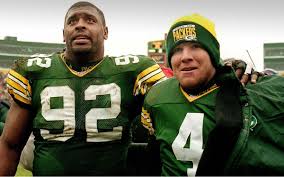On November 15, 1992, the Green Bay Packers defeated the Philadelphia Eagles 27-24 at Milwaukee County Stadium. While few people remember much about that game, it was instrumental in changing the history of the Packers franchise and setting in motion an era of success that the team had not enjoyed since Vince Lombardi left the sidelines after the 1967 season.
It was Mike Holmgren’s first year as coach in Green Bay. The Pack entered the game with a 3-6-0 record while the Eagles were playoff contenders at 6-3-0. The Packers were clearly better than the 4-12 team of the previous year, but another loss and their playoff hopes were all but over and the team would be on its way to its 20th losing season in the last 25 years.
The Packers took a 21-10 lead early in the fourth quarter when quarterback Brett Favre, who was starting only his seventh game for the team, hit running back Darrell Thompson on a three-yard touchdown pass. But Eagles quarterback Randall Cunningham led his team back and Philadelphia took a 24-21 lead when Herschel Walker scored on a two-yard run with time running out in the game.
But Favre was determined and led the Packers on two more scoring drives. The first led to a 31-yard field goal by Chris Jacke to tie the game at 24-24 with 1:31 remaining. Then, Favre got the Pack in field goal range again and Jacke booted a 41-yard kick to win it 27-24 on the game’s final play.
https://www.youtube.com/watch?v=rACnSeUNBlk
Favre finished the game 23-of-33 for 275 and two touchdowns. In typical Favre fashion, he also threw two interceptions. Tight end Jackie Harris had eight catches for 98 yards while Favre’s favorite target, Sterling Sharpe, had seven grabs for 116 yards and a touchdown.
But the moment that changed the franchise’s future took place on the second possession of the game. Eagles all-world defensive end Reggie White had sacked Favre and separated his left shoulder.
“I wasn’t going to let him know he hurt me,” Favre said and the second-year quarterback out of Mississippi State stayed in the game and led the Packers to this comeback victory.
White knew he had injured Favre but was impressed by the quarterback’s toughness and ability to play through the pain and lead his team to victory.
“That was the game that proved to me that Brett was going to be the player that he [became],” White later admitted. “I mean, he came out and I knew I had separated his shoulder. When he came back out [and played], the first thing that ran through my mind was, `This guy’s going to be good.’”
The following spring, White was the biggest prize of the NFL’s first ever true free agent class. He remembered the toughness and leadership Favre had shown the previous November and it was a big factor in his decision to sign with the Packers. Holmgren, GM Ron Wolf and defensive coordinator Ray Rhodes were able to convince White to sign a four-year, $17 million deal to come to Green Bay.
When White signed with the Pack, the team made the playoffs in each of the six seasons he played there after making the playoffs only twice between 1968-1992. White’s signing also proved that the NFL’s smallest city could compete for free agents. More importantly, it helped change Green Bay’s reputation as a place that was not ideal for African-American athletes to live and play in.
“Before that decision guys would say, ‘If Green Bay drafts me, I don’t want to go.’ It was Siberia,” former Packers tight end Keith Jackson told Sports Illustrated. “But Reggie White saw something different about it. Reggie saw all these positives about Green Bay that nobody really knew about,” Jackson added. “He saw it as an opportunity to go somewhere where the people are super fans. And when you lose a game, there’s nobody screaming at you saying you’re a bum. The media is reporting the facts and not trying to create a controversy. It was actually an oasis to play football, and you really concentrated on being a football player.”
Jamie Dukes, who signed with the Packers as a free agent one year after White, admitted that Reggie’s decision made his possible. “There is no question, had Reggie not gone to Green Bay to make Green Bay cool, that wouldn’t have happened,” says Dukes explained. “Prior to that, Green Bay wasn’t on the menu of places you wanted to go.”
The signing of White gave instant credibility to the Packers defense on the field and gave the franchise credibility with African-American players off the field as a place they could play and be comfortable.
Without the events of November 15, 1992, the history of the Green Bay Packers would have been very different. It was a key component that helped usher in an era of success that continues to this day.
Follow Gil Martin on Twitter @GilPackers
Click here for more great Packers coverage
Add The Sports Daily to your Google News Feed!
